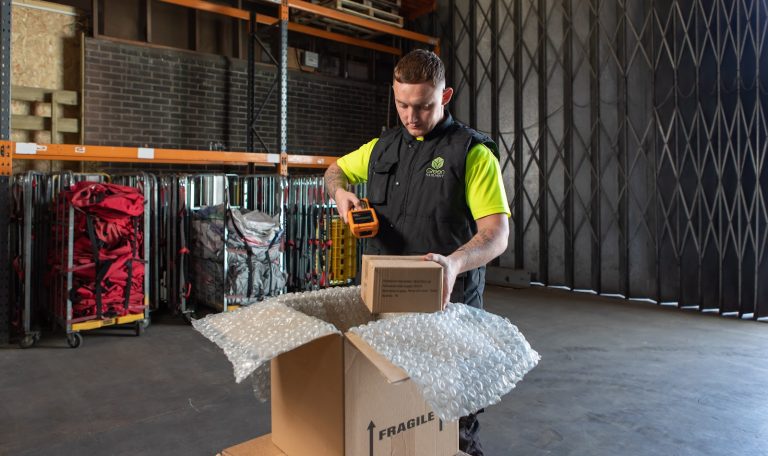Article summary
- How UK fashion brands cut carbon and stay competitive after Brexit
- Micro-fulfilment hubs reduce delivery distances by up to 60%
- Lockers, click-and-collect, and consolidation limit failed deliveries
- Dual UK–EU fulfilment cuts customs delays and reduces emissions by up to 70%
- Packaging strategies improve efficiency through right-sizing, lightweight materials, and circular design
- Returns over 30% raise emissions, but smarter prevention and collection lower the impact
- Sustainable shipping costs 10–25% more, with green delivery windows balancing speed and savings
- Six-step plan covers audits, courier choice, packaging, returns, inventory, and communication
- Green Fulfilment supports fashion brands with multi-location fulfilment, carbon-conscious shipping, and advanced logistics tech
The fashion industry accounts for 10% of global carbon emissions, with supply chains responsible for 80% of that impact. Yet most sustainability conversations focus on materials and manufacturing while ignoring a critical piece: shipping and logistics.
UK fashion brands face unique challenges post-Brexit. Cross-border delays, rising consumer expectations for sustainable delivery, and the complexity of managing returns across multiple markets create both problems and opportunities. The brands getting this right are building competitive advantages that go far beyond their environmental credentials.
The Last-Mile Revolution: UK Fashion’s Delivery Innovation
UK fashion brands are pioneering new approaches to cut emissions in the final stretch to customers’ doors. Electric delivery fleets have moved from trial to mainstream, with major couriers now offering zero-emission options across urban areas.
Micro-fulfilment networks represent the biggest shift in UK fashion logistics. Many brands now work with third-party logistics (3PL) providers to position inventory in regional hubs across the country. This approach reduces reliance on a single warehouse, improves warehousing and storage flexibility, and ensures faster order fulfilment closer to customers.
Consolidation strategies are proving equally valuable. Brands batching orders for specific postcodes report notable per-item carbon savings, with some case studies suggesting reductions of up to 30%. Some are partnering with other fashion retailers to share delivery routes, particularly for rural areas where individual deliveries are carbon-intensive.
Alternative delivery models are gaining traction too. Click and collect services, pickup points, and locker networks eliminate failed delivery attempts – a hidden carbon cost that can double transport emissions per order.

Beyond Brexit: Smart UK and EU Shipping Strategies
Post-Brexit logistics have created unexpected sustainability opportunities for UK fashion brands. The complexity of cross-border shipping has pushed many to reconsider their entire distribution strategy.
The Domestic Advantage
UK-based inventory delivers clear carbon benefits:
- Eliminates customs delays and paperwork
- Reduces packaging requirements
- Cuts transport distances significantly
- Delivers 40-50% emission reductions when serving UK customers from domestic stock
Dual-Strategy Approach for European Markets
Smart brands now operate split strategies rather than single-warehouse models:
UK Fulfilment Hub:
- Handles all domestic UK orders
- Faster delivery times
- Lower shipping costs
EU-Based Inventory:
- Serves continental European customers
- Requires higher inventory investment
- Reduces shipping emissions by up to 70% compared to cross-border deliveries
Modal Shift Opportunities
UK-EU transport routes offer significant sustainability improvements:
Sea Freight Benefits:
- Generates 90% fewer emissions than air transport
- Cost-effective for planned inventory movements
- Ideal for seasonal stock positioning
Rail Connections:
- Improving rapidly across UK-EU routes
- Perfect middle ground between speed and sustainability
- Brands planning seasonally can dramatically reduce their logistics footprint
The key is choosing slower, greener transport modes for inventory movements while maintaining fast local delivery to end customers.
Packaging That Actually Works With Shipping
Most sustainable packaging initiatives focus on materials while ignoring how packaging affects transport efficiency. Forward-thinking brands work closely with their order fulfilment partners to integrate packaging decisions into wider shipping and logistics strategy
1. Right-Sizing Technology
Packaging that perfectly fits products reduces void fill, cuts box dimensions, and increases transport density. Reducing package size can cut emissions by improving vehicle utilisation; even modest reductions can translate into meaningful carbon savings.
2. Weight Optimisation
Switching from traditional cardboard to lightweight alternatives can cut shipping costs and emissions by 10-15%. Some UK brands are experimenting with innovative materials like seaweed-based packaging that’s both biodegradable and ultra-lightweight.
3. Circular Design
Packaging designed for easy returns – with tear-off labels and reversible surfaces – reduces repackaging needs and encourages customers to use existing materials for returns.

Returns: Fashion’s Hidden Carbon Problem
January “Returnuary” reveals the scale of fashion’s returns challenge. UK fashion brands face return rates exceeding 30%, effectively doubling the transport emissions per sale. Yet few brands factor returns into their sustainability strategies.
Processing Efficiency First
Quick turnaround times – inspecting, cleaning, and restocking returned items within 48 hours – prevent inventory from becoming deadstock while maintaining customer satisfaction.
Smart Collection Strategies
UK brands are pioneering sustainable returns collection approaches:
- Partner with couriers to collect returns during regular delivery rounds
- Route returns to the nearest processing facilities rather than the original dispatch centres
- Consolidated collection strategies can substantially reduce emissions from returns, particularly when paired with local processing.
Technology Solutions
- Smart returns routing directs items to optimal processing locations
- Condition assessment apps help customers determine return suitability
- Reduce unnecessary shipments through better pre-return screening
Prevention Beats Collection
Better product information delivers the biggest impact:
- Professional product photography
- Detailed size guides and fabric information
- Reduce return rates by 20-30%
- Carbon savings often exceed those from greener shipping methods
The Cost Reality: Sustainable Shipping Premiums
Carbon-neutral shipping often comes at a premium compared to standard delivery, with many services costing 10–25% more depending on the courier and region. This premium reflects the true cost of electric vehicles, renewable energy, and carbon offset programmes.
Customer willingness to pay varies significantly. Research suggests 54% of UK consumers expect sustainable delivery options, but only 30% will pay extra for them. This gap forces brands to absorb costs or find creative solutions.
Speed versus sustainability creates ongoing tension. Next-day delivery remains a powerful sales driver, but it’s often the least sustainable option. Brands are experimenting with “green delivery windows” – offering discounts for customers willing to accept longer, more sustainable delivery timeframes.
ROI calculations for sustainable logistics extend beyond direct costs. Brand reputation benefits, customer loyalty improvements, and regulatory compliance advantages often justify the investment. Some brands report measurable improvements in customer loyalty after implementing comprehensive sustainable shipping programmes.
Your Action Plan: Six Steps to Sustainable Fashion Shipping
Step 1: Audit Your Current Footprint
Map your shipping emissions across all channels. Include returns, failed deliveries, and packaging in your calculations.
Step 2: Evaluate UK Courier Options
Compare carbon-neutral programmes from major carriers. DPD’s carbon-neutral service, Royal Mail’s carbon-neutral delivery, and other green options each have different coverage and cost structures.
Step 3: Optimise Packaging Strategy
Right-size packaging for shipping efficiency. Test lightweight alternatives and design for easy returns processing.
Step 4: Implement Returns Prevention
Improve product information and size guidance. Consider virtual fitting tools or detailed measurement guides to reduce return rates.
Step 5: Strategic Inventory Positioning
Position stock closer to customers through regional fulfilment or partner with logistics providers who offer multi-location services.
Step 6: Measure and Communicate
Track emissions per order, return rates, and customer satisfaction with sustainable delivery options. Share progress transparently with customers.
Ready to put these steps into practice? Get a fulfilment quote and see how we can help your brand ship smarter and more sustainably
Frequently Asked Questions
1. Which UK couriers offer genuine carbon-neutral shipping for fashion brands?
DPD Local, Royal Mail, and Evri all offer carbon-neutral programmes, though each uses different methodologies. DPD focuses on electric vehicles in urban areas, while Royal Mail relies more on offsetting programmes.
2. How much more does sustainable shipping cost UK fashion brands?
Expect 15-25% premiums for certified carbon-neutral delivery. Urban electric vehicle services typically cost 10-15% more, while rural deliveries with offsetting increase costs by 20-30%.
3. Should UK fashion brands use EU fulfilment centres for sustainability?
EU fulfilment can reduce shipping emissions by 60-70% when serving European customers, but requires splitting inventory. The carbon benefits usually justify the operational complexity for brands with significant EU sales.
4. How can fashion brands reduce returns to cut shipping emissions?
Detailed product information and professional photography can reduce return rates by 15-30%. These prevention strategies often deliver bigger carbon savings than greener return shipping methods.
The future belongs to fashion brands that integrate sustainability into their logistics strategy rather than treating it as an add-on. The brands making these changes now are building competitive advantages that will define the next decade of fashion retail.




